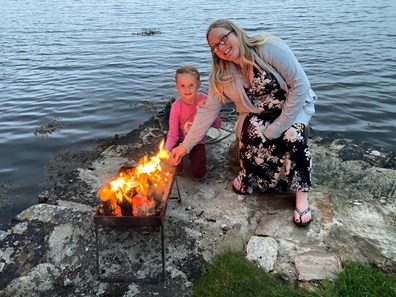Meeting new people with Charlotte
Published Date: 19 Aug 2021
During a recent family holiday, we made some new friends. Obviously as a family, deaf awareness is very important to us and we are all passionate about Charlotte being able to have the same opportunities as everyone else despite her deafness. However, how do you deal with introducing deafness and deaf awareness to new friends without being patronising or making an issue of it?
As Charlotte usually wears cochlear implants, which are colourful and mostly on top of her hair, there is a visual cue there already. Despite this, many people haven’t a clue what cochlear implants are or what it means when someone is wearing them. Sometimes just seeing these on her head opens a conversation and then we can choose what to say and how to explain to match their level of understanding. It can be very difficult for other people to understand that cochlear implants are not a cure for deafness and don’t mean that once Charlotte is wearing them she can hear everything. Remember that as a family with a deaf child, we’ve had years of research, education and experience to understand what this means for our family and specifically for Charlotte.
We use meeting new people as an opportunity to talk about simple deaf awareness. We call Charlotte to get her attention before we start speaking, give her instructions while making sure that she can see our full face, we don’t talk when we’re eating or have our mouths covered and we take it in turns to speak. During the time we’re together, I’ll try to model these deaf awareness behaviours, as well as demonstrate how to repeat myself if Charlotte didn’t hear me or understand what I’ve been saying.
We also use sign language to communicate at times, which can again open up a conversation with new friends. People ask if we’re signing and why, this gives us a chance to explain how Charlotte can hear sometimes but can’t when she removes her cochlear implants. It’s also a chance to show how to enhance communication in a noisy environment or when using new words/names. Some people will ask to be taught a few simple signs to help Charlotte if she needs them.
Over the years, we’ve found everyone to be supportive and keen to make sure that they communicate effectively with Charlotte and I strongly believe it’s because we are so open about her abilities and needs. Deafness is not a bad word, it’s something we celebrate and promote as part of Charlotte’s uniqueness. Just as we celebrate her brother’s love of art and music or another brother’s sporting achievements.
During the holiday I mentioned, we were staying on a remote country lane. There were several cars coming up and down everyday, including some electric cars which are pretty silent. Our new friend, who was a regular in the area and knew the local residents, chatted with each of the drivers, explaining that Charlotte was deaf, that she wouldn’t always be wearing her cochlear implants and that they would need to slow down when driving and watch out for her, instead of relying on her to see them.
Inclusion, acceptance and normality matters, but if we don’t educate others on deafness and what it means for our children, there’s a risk of being excluded and isolated in many aspects of their lives.
